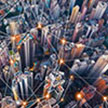
How nanotechnology can benefit smart cities
A smart city is an infrastructure framework that addresses the growing urbanization challenges by embracing integrated and automated information and communication technologies to help optimize all city operations, help achieve sustainability goals and better quality of life for its citizens (read our primer on smart cities).
Generally, the development of smart cities requires more efficient and less polluting transport systems, more habitable residential buildings that require less energy to operate, establishment of better managed public services of all kinds (gas, water, electricity, waste disposal, etc.).
Working towards this goal involves developing and using technologies on several fronts. Some of the challenges are:
The development of lighter and more resilient materials whose manufacture requires less energy, for use in transportation or buildings;
The development of electric cars by designing new batteries or development of hydrogen technologies;
The design of vehicles and systems that allow automatic driving;
The design and manufacture of more resistant construction materials, capable of self-repair that remove air pollution, helping to purify the city’s air;
The development of new building materials capable of photovoltaic energy generation, or able to filter light based on brightness;
The development of low-power lighting and signaling systems;
Establishing extensive networks of sensors that monitor traffic, parking spaces, waste disposal utilization, air pollution, the presence of pollen, the temperature, the number of pedestrians, the moisture content of soil in public parks, etc. in real time and with pinpoint accuracy;
The development of networked devices that are able to make decisions automatically and autonomously;
Support of control and observation tasks by system drones;
The development of systems for storage and processing of the huge amount of data collected in order to improve information systems, decision-making, power grid and water network management, the participation of citizens in city government, etc.
Just going through this list it becomes clear that the development of smart cities is linked to the development of new materials and devices, the use of sensor networks, the handling of huge amounts of data (‘Big Data’), the development of communication networks between objects, decision-making (‘Artificial Intelligence’), data security and decentralization (‘blockchain’), and a range of other smart technologies. This leads to and integrates with new concepts such as Smart Roads and Smart Factories.
Generally, the development of smart cities requires more efficient and less polluting transport systems, more habitable residential buildings that require less energy to operate, establishment of better managed public services of all kinds (gas, water, electricity, waste disposal, etc.).
Working towards this goal involves developing and using technologies on several fronts. Some of the challenges are:
The development of lighter and more resilient materials whose manufacture requires less energy, for use in transportation or buildings;
The development of electric cars by designing new batteries or development of hydrogen technologies;
The design of vehicles and systems that allow automatic driving;
The design and manufacture of more resistant construction materials, capable of self-repair that remove air pollution, helping to purify the city’s air;
The development of new building materials capable of photovoltaic energy generation, or able to filter light based on brightness;
The development of low-power lighting and signaling systems;
Establishing extensive networks of sensors that monitor traffic, parking spaces, waste disposal utilization, air pollution, the presence of pollen, the temperature, the number of pedestrians, the moisture content of soil in public parks, etc. in real time and with pinpoint accuracy;
The development of networked devices that are able to make decisions automatically and autonomously;
Support of control and observation tasks by system drones;
The development of systems for storage and processing of the huge amount of data collected in order to improve information systems, decision-making, power grid and water network management, the participation of citizens in city government, etc.
Just going through this list it becomes clear that the development of smart cities is linked to the development of new materials and devices, the use of sensor networks, the handling of huge amounts of data (‘Big Data’), the development of communication networks between objects, decision-making (‘Artificial Intelligence’), data security and decentralization (‘blockchain’), and a range of other smart technologies. This leads to and integrates with new concepts such as Smart Roads and Smart Factories.
www.nanowerk.com



